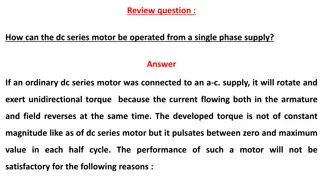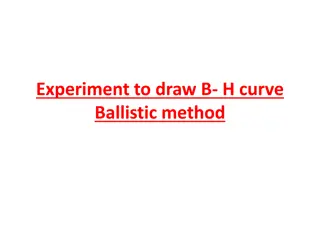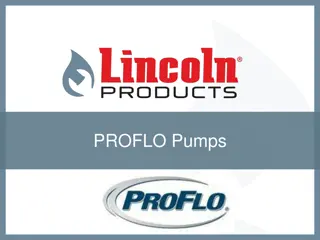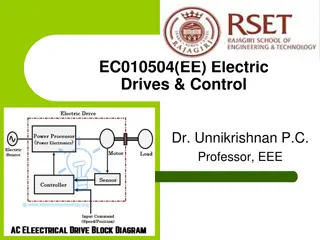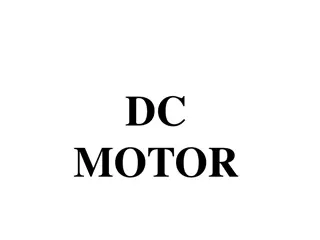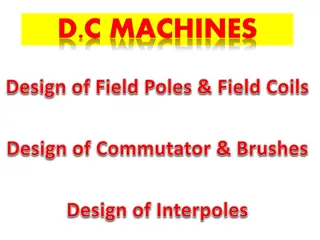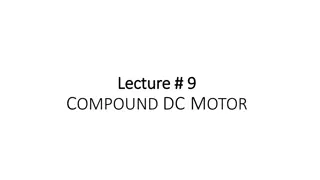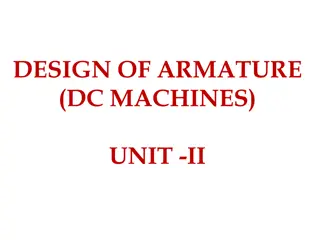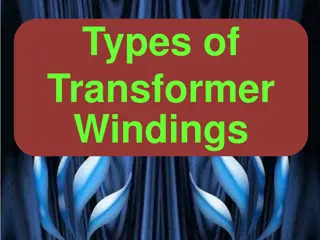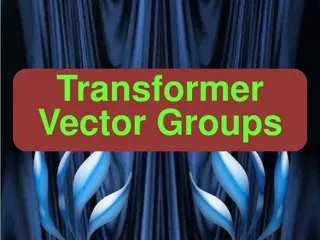Operating a DC Series Motor from a Single Phase Supply
Connecting a DC series motor to an AC supply results in pulsating torque due to reversed current flow. This setup leads to inefficiencies and challenges such as eddy current losses and poor power factor. To improve performance, modifications like laminating core structures, using compensated winding
0 views • 23 slides
Experimental Method to Draw B-H Curve Using Ballistic Approach
Conducting an experiment to draw a B-H curve using the ballistic method involves a setup with primary and secondary windings, a ferromagnetic specimen, and various circuit components. By passing a current through the primary coil and measuring the induced emf in the secondary circuit, the relationsh
0 views • 16 slides
DC Machine Armature Windings Overview
Learn about the construction and types of armature windings in DC machines, including lap wound and wave wound armatures. Discover how lap wound armatures are suitable for low voltage, high current applications, while wave wound armatures are used in high voltage, low current scenarios. Understand t
0 views • 18 slides
PROFLO Utility Pumps: Types, Features, and Comparison
Learn about PROFLO utility pumps including various types such as utility, sump, effluent, sewage, and battery backup pumps. Explore a detailed description of Lincoln Stocking Cross models, pump terminology, and the unique features of PROFLO pumps. Discover pump characteristics like pump head, GPMs,
1 views • 24 slides
Understanding Induction Motors: Construction and Characteristics
Induction motors are widely used in various applications due to their advantages like robustness, high power-to-weight ratio, and low cost. However, they have limitations such as fixed speed operation. These motors consist of a stationary stator and a rotating rotor, with different designs like squi
0 views • 50 slides
Understanding DC Motors: Principles, Construction, and Operation
DC motors are essential components that convert electrical energy into mechanical energy. This article explores the working principle of DC motors, covering topics such as windings, construction, key components like yoke, poles, armature, and commutator. Learn how current-carrying conductors interac
0 views • 31 slides
Understanding Magnetic Circuits in DC Machines
A magnetic circuit in a DC machine includes components like yoke, poles, air gap, armature core, and more, through which magnetic flux flows. The design of field windings, such as shunt and series windings, plays a crucial role in the operation of the machine. Determining factors for the field windi
0 views • 55 slides
Comparison of Compound DC Motors and Their Characteristics
Compound DC motors, including cumulative, differential, and compound configurations, offer unique operational features based on how the series and shunt field windings are connected. Cumulative compound motors provide improved torque characteristics but lower speed, while differential compound motor
0 views • 12 slides
Understanding the Design and Elements of Armature in DC Machines
The design of armature in DC machines involves various factors such as armature windings, number of conductors, coils, slots, voltage drop, peripheral speed, and more. Armature winding arrangements play a crucial role in producing electromotive forces through relative motion in a magnetic field. Com
0 views • 27 slides
Understanding Transformer Windings: A Comprehensive Guide
This comprehensive guide delves into the intricacies of transformer windings, explaining the concepts of turns, coils, and windings in detail. It covers the different types of windings, materials used, and considerations for designing windings, providing valuable insights for anyone interested in el
0 views • 21 slides
Understanding Transformer Vector Groups in Transformer Systems
Transformer vector groups play a crucial role in determining the phase relationships between high and low voltage sides in transformer windings. Proper understanding of vector groups is essential for parallel connection of transformers to prevent phase differences and potential short circuits. The a
0 views • 36 slides
